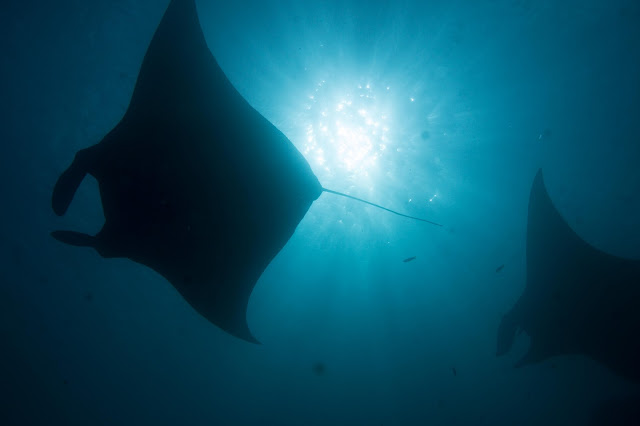Manta Protocol - 6 tips for diving with Manta Rays
With out a
doubt, diving with Mantas is one of the most exhilarating and wonderful
experiences you can ever have. They are beautiful, majestic creatures that are
extremely curious and intelligent. However, the world they live in is a
delicate one, and our interaction can have a huge effect on whether they will
keep returning to the dive sites where they are regularly spotted. So, how can
we make sure we are diving with Mantas sustainably? Well, read on to find out
more:
 |
| Photo Credit: Daan Meiboom |
1. Keep your distance
 |
| They will swim over the top of you! |
Mantas are
curious, no doubt about it. They will swim right up to you, look you in the
eye, then swim away. It’s intense and it’s magical. However, don’t let this
interaction lead you to believe that it’s ok to get too close. It is recommended
that all divers and snorkelers stay 3m away from a Manta Ray, allowing it to
move in whatever way it feels comfortable.
- Are there any exceptions to this?
If a Manta chooses to come to you,
it’s a slightly different story. A great advantage of dive sites such as ‘Mawan’ in the Komodo
National Park is that there is a huge sandy patch. This allows divers to
get close to the seabed without fearing damaging corals, and the Mantas Rays will then approach them. Being approached by a
manta is very different to swimming towards it. Allow them to control the interaction.
2. Stay calm – no need to rush
Many people
get tempted to speed towards a Manta as fast as possible – fearing it will swim
away not to be seen again. Let’s get one thing straight… A Manta Ray will
always beat you in a swimming race. So, save your energy, save your air, and
stay calm. Stay where you are and the manta will come to you!
3. Don’t enter the cleaning station
This is something
that we cannot stress enough. The cleaning station and the behaviour associated with it is an integral part of their daily routine. It’s a fascinating thing to watch and an extremely important
process for the health of the ray. Certain fish remove certain things. Some remove algae, some clean the
gills, others clean wounds preventing infection. The reason these fish are in
the area is because of the corals. By entering a cleaning station you could
easily knock the corals, causes them to become distressed and possibly die.
No
corals = no fish = no mantas L
 |
| Photo Credit - Bent Christensen |
- How do I know it’s a cleaning station?
It’s
difficult as any coral bombie has the potential to be a Manta cleaning station.
The best thing to do is make sure you listen to your dive guides briefing and
watch them during the dive. If you start getting too close they will call you
back away from the cleaning station area. In most ‘Manta Dive Sites’ there will
be a couple of main cleaning stations that the guides are aware of, they will
bring you to them to show you but also control where you are in the water.
4. Keep your hands to yourself
 As tempting
as it can be, when a Manta flies over the top of your head, to reach out and
touch it…Don’t! By touching a manta ray you are disturbing their natural
behaviour. Not only that, but we’re sure you don’t want random people touching
you? Mantas are much more likely to reduce their interaction time if they are
touched.
As tempting
as it can be, when a Manta flies over the top of your head, to reach out and
touch it…Don’t! By touching a manta ray you are disturbing their natural
behaviour. Not only that, but we’re sure you don’t want random people touching
you? Mantas are much more likely to reduce their interaction time if they are
touched.
5. Avoid flash photography
Using a
bright light – especially straight into their eyes - can also be detrimental to Mantas. Again, you wouldn’t like it
done to you, so don’t do it to them. It’s a sure fire way to end your manta
interaction quickly.
That said,
we do encourage photos of mantas – mainly of the underside of their belly. This allows our good
friends over at the Marine Mega Fauna Foundation to ID them and gather vital sightings data so we find out more
about this amazing species! For more information got to mantamatcher.org
6. Enjoy yourself!
As we’ve
already said, diving with Mantas is an unforgettable experience. By following
these guidelines, not only will you extend your interaction time but also help
make sure that Mantas will be around for future generations to enjoy too!



Comments
Post a Comment